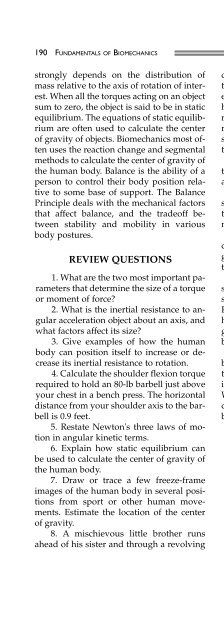Fundamentals of Biomechanics
Fundamentals of Biomechanics
Fundamentals of Biomechanics
Create successful ePaper yourself
Turn your PDF publications into a flip-book with our unique Google optimized e-Paper software.
190 FUNDAMENTALS OF BIOMECHANICS<br />
strongly depends on the distribution <strong>of</strong><br />
mass relative to the axis <strong>of</strong> rotation <strong>of</strong> interest.<br />
When all the torques acting on an object<br />
sum to zero, the object is said to be in static<br />
equilibrium. The equations <strong>of</strong> static equilibrium<br />
are <strong>of</strong>ten used to calculate the center<br />
<strong>of</strong> gravity <strong>of</strong> objects. <strong>Biomechanics</strong> most <strong>of</strong>ten<br />
uses the reaction change and segmental<br />
methods to calculate the center <strong>of</strong> gravity <strong>of</strong><br />
the human body. Balance is the ability <strong>of</strong> a<br />
person to control their body position relative<br />
to some base <strong>of</strong> support. The Balance<br />
Principle deals with the mechanical factors<br />
that affect balance, and the trade<strong>of</strong>f between<br />
stability and mobility in various<br />
body postures.<br />
REVIEW QUESTIONS<br />
1. What are the two most important parameters<br />
that determine the size <strong>of</strong> a torque<br />
or moment <strong>of</strong> force?<br />
2. What is the inertial resistance to angular<br />
acceleration object about an axis, and<br />
what factors affect its size?<br />
3. Give examples <strong>of</strong> how the human<br />
body can position itself to increase or decrease<br />
its inertial resistance to rotation.<br />
4. Calculate the shoulder flexion torque<br />
required to hold an 80-lb barbell just above<br />
your chest in a bench press. The horizontal<br />
distance from your shoulder axis to the barbell<br />
is 0.9 feet.<br />
5. Restate Newton's three laws <strong>of</strong> motion<br />
in angular kinetic terms.<br />
6. Explain how static equilibrium can<br />
be used to calculate the center <strong>of</strong> gravity <strong>of</strong><br />
the human body.<br />
7. Draw or trace a few freeze-frame<br />
images <strong>of</strong> the human body in several positions<br />
from sport or other human movements.<br />
Estimate the location <strong>of</strong> the center<br />
<strong>of</strong> gravity.<br />
8. A mischievous little brother runs<br />
ahead <strong>of</strong> his sister and through a revolving<br />
door at a hotel. The little brother pushes in<br />
the opposite direction <strong>of</strong> his sister trying to<br />
exit. If the brother pushes with a maximum<br />
horizontal force <strong>of</strong> 40 pounds acting at a<br />
right angle and 1.5 feet from the axis <strong>of</strong> the<br />
revolving door, how much force will the<br />
sister need to create acting at 2.0 feet from<br />
the axis <strong>of</strong> rotation to spoil his fun?<br />
9. What mechanical factors can be used<br />
to maximize stability? What does this do to<br />
a person's mobility?<br />
10. What movement factors can a kinesiology<br />
pr<strong>of</strong>essional qualitatively judge<br />
that show a person's balance in dynamic<br />
movements?<br />
11. Say the force F 2 applied by the student<br />
in Figure 7.3 acted 55º in from the tangent<br />
to the merry-go-round. Calculate the<br />
torque created by the student.<br />
12. Draw a free-body diagram <strong>of</strong> a person<br />
standing on a reaction board (hint: the<br />
system is the body plus the board).<br />
Estimate the length <strong>of</strong> the board and the<br />
horizontal distance to the person's center <strong>of</strong><br />
gravity. Calculate the reaction force on the<br />
board if you were the person on it.<br />
13. If the rotary component <strong>of</strong> a<br />
brachialis force is 70 N and the muscle attaches<br />
0.4 m from the axis <strong>of</strong> rotation, what<br />
is the flexor torque created by the muscle?<br />
What other information do you need in order<br />
to calculate the resultant force created<br />
by the brachialis?<br />
KEY TERMS<br />
Balance Principle<br />
center <strong>of</strong> gravity<br />
inertial force<br />
moment arm<br />
moment or moment <strong>of</strong> force<br />
moment <strong>of</strong> inertia<br />
reaction change<br />
segmental method<br />
static equilibrium<br />
torque






